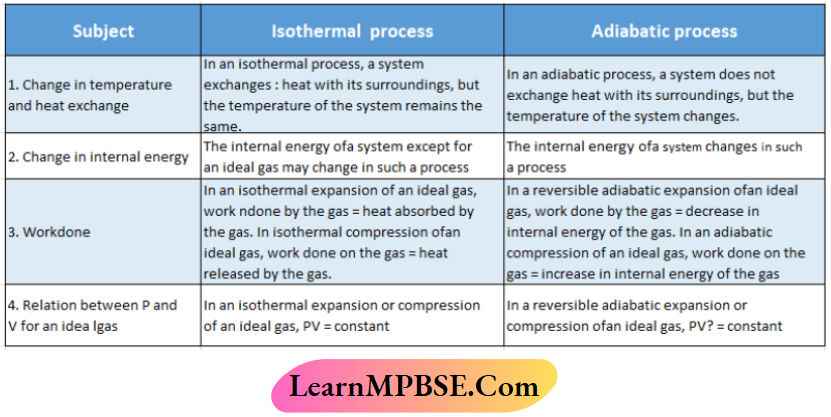Thermodynamics Class 11 Chemistry Notes
Thermodynamic Process
Thermodynamic Process Definition:
A system is said to undergo thermodynamics. A pathway of process: The sequence of system a system process when it undergoes a processis called the pathways of process
Cyclic process Definition
A system is said to haw undergone a cyclic process I if it returns to Its initial state after a series of successive
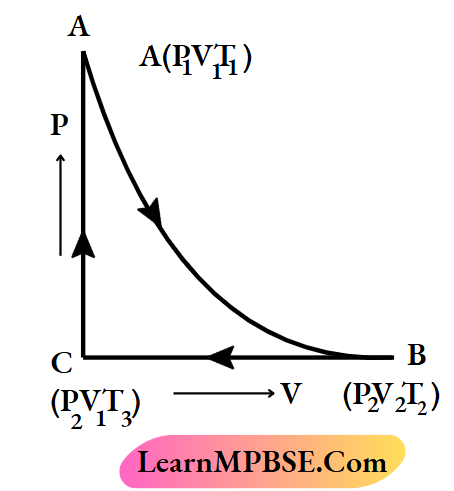
Cyclic process Explanation:
Let us consider a process, in which the initial state of a gaseous system is A (Pv Tx). The system returns to its initial state after undergoing consecutive returns to its initial state through three successive operations, it is a cyclic process.
| Class 10 Science | Class 11 Chemistry |
| Class 11 Chemistry | Transformation of Sentences |
| Class 8 Maths | Class 8 Science |
Class 11 Chemistry Notes For Thermodynamic Process
Cyclic process Example:
The following change indicates a cyclic process because 1 mol of water (system) returns to its initial state again through successive changes
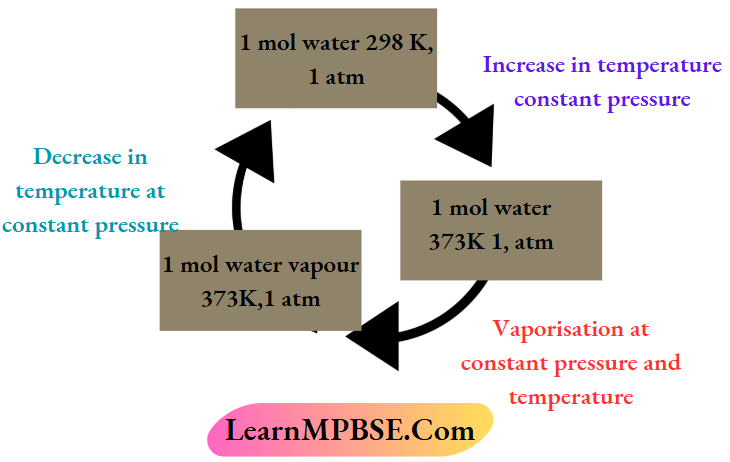
The changes in state functions are zero in a cyclic process. The value of a state function depends upon the present state of the system. Since the initial and the final states of the system are the same in a cyclic process, the rallies of the state functions in these two states are also the same. So die change in state function (ΔP, ΔV,ΔT,ΔU’, ΔH, etc.) becomes zero for a cyclic process
Isothermal process Definition
If the temperature of a thermodynamic system remains constant throughout a process, then the process Is said to be an Isothermal process,
At the time of conducting this process, the system Is kept lit contact with «a constant temperature heal hath (f.u, thermostat) with a high heat capacity. Such a heat hath Is capable of gaining or losing heat without changing Its temperature.
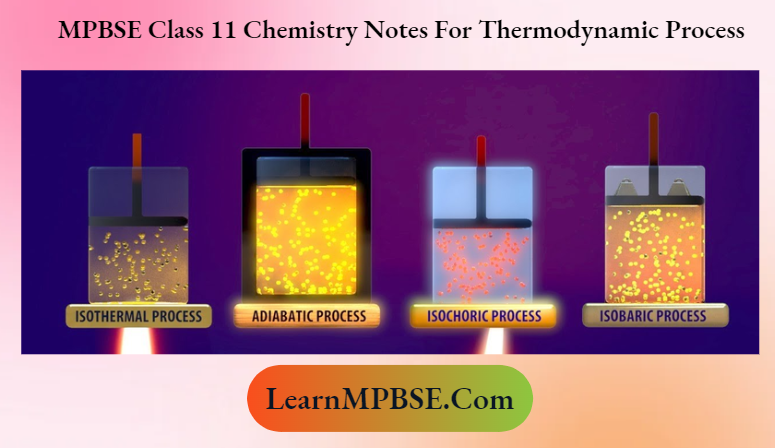
Condition(s) for the isothermal process:
During an Isothermal process, the temperature of the system remains constant. So we can write,dT ‘[system] = constant and d’V[system] or ΔT [system] = 0.
Thermodynamic Process Class 11 Notes
Condition(s) for the isothermal process Example:
The boiling of a liquid at its boiling point Is an isothermal process. This Is because the temperature of the liquid remains constant until the entire liquid converts to vapor. Thus, the boiling ofwater at 100°C and l atm is an isothermal process.
The temperature of the system remains fixed in the isothermal process. U does not mean that heat is not absorbed or liberated by the system during this process.
Isobaric process Definition
A process in which the pressure of the system remains fixed at each step of the process is called an isobaric process.
Condition(s)t for this and the isobaric process:
As the pressure of the system during this process remains constant P{system)=constant and dp (system)or ΔP (system) =0
Isobaric process Example:
The vaporization of any liquid in an open container occurs under atmospheric pressure. If the atmospheric pressure remains fixed, then the process of vaporization is said to be an isobaric process
Isochoric process Definition:
The isochoric process in Which the volume of the system remains constant throughout the process is called an isochoric to process.
Condition(s) for the isochoric process:
The volume of the system remains constant during this process. Hence, V[system] = constant and dV[system] or ΔV [system] =0
Isochoric process Example: The combustion of n substance In a bomb calorimeter.
For a closed system consisting of an ideal gas. the plots of P vs V for
- Isothermic
- Isobaric and
- Isochoric changes
These are given below:
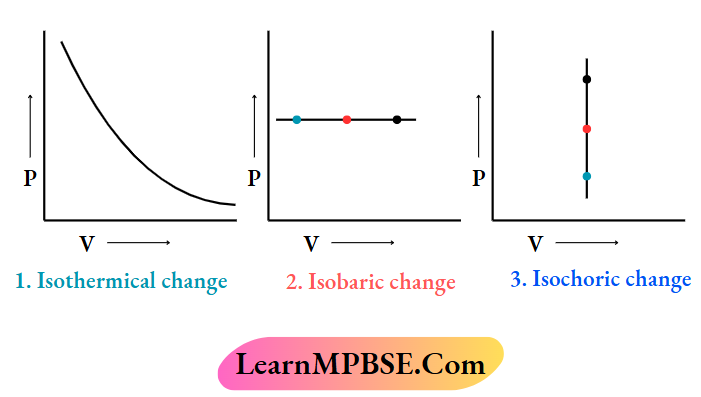
Thermodynamic Equilibrium Class 11
Adiabatic process Definition
A process in which no exchange of heat takes place between the system and Its surroundings at any stage of the process is called an adiabatic process.
This process requires the system to be covered with a perfect thermal insulator. But in reality, no such material is available and hence the process never becomes one hundred percent adiabatic.
Condition(s) for adiabatic process:
No heat is exchanged between a system and its surroundings In an adiabatic process. So, for such type of process q – 0; where q = heat absorbed or released by the system.
Adiabatic process Example:
The sudden expansion or compression of a gas is considered to be an adiabatic process because when a gas (system) undergoes such a process, it does not get a chance to exchange heat with its surroundings. As a result, the sudden compression of a gas results in an increase in the temperature of the gas, while its sudden expansion leads to a decrease in temperature. For example, when the valve ofa bicycle or car tire is removed, the air coming out ofthe tire undergoes very fast expansion and gets cold.
- The temperature of a system does not remain constant in an adiabatic process (except in the case of an adiabatic expansion of an Ideal gas against zero pressure).
- For a process involving more than one step, the algebraic sum of heat absorbed or released in different steps may be zero q1 + q2 + q3 + ……………….. = 0, but it does not mean that the process is an adiabatic one.
Reversible process Definition
A process It salt! to be reversible If It Is carried out Infinitesimally slowly so that In each step the thermodynamic equilibrium of the system Is maintained, and any Infinitesimal change In conditions can reverse the process to restore both the system and Its surroundings lo their Initial states.
Thermodynamic Equilibrium Class 11
Reversible process Explanation:
Let us consider that the gas (system) Is enclosed lit a cylinder lilted with a weightless and frictionless piston and the cylinder is kept At a constant temperature hath (surroundings). So, any change occurring In the ire system would be Isothermal. Since the temperature of the system and surroundings tiro the same, the system will remain In thermal equilibrium.
Let the applied external pressure acting on the piston Is the same as that of the gas. So, the system will remain In mechanical equilibrium. Hence, In this condition, the system, the gas Is In a state of thermodynamic equilibrium and pthe roperties of the system remain unchanged

Now, if the external pressure is decreased by an infinitesimal amount dP, the volume of the gas will increase very slowly by an infinitesimal amount until the pressure of the gas becomes equal to that of the external pressure.
- Let the infinitesimal increase of volume = dV. If the external pressure is further decreased by an Infinitesimal amount of dP, the volume of the gas will also increase by an infinitesimal amount of dV.
- In this way, if the gas is allowed to expand very slowly in an infinite number of steps by decreasing an infinitesimal amount (dP) of the external pressure at each step, then the expansion ofthe gas will reversibly take place.
- In a step, if the external pressure is increased by an infinitesimal amount (dP), then the volume of the gas will decrease by an infinitesimal amount dV.
- Hence, by decreasing or increasing the external pressure by an infinitesimal amount, the direction of the process can be reversed.
Thermodynamic Equilibrium Class 11
Characteristics of a reversible process:
- The driving force of a reversible process is infinite¬ simply greater than the opposing force and by increasing or decreasing the driving force by an infinite¬ amount, the direction of the process can be changed.
- In this process, the system remains in thermodynamic equilibrium at every intermediate step. This process is extremely slow. From a theoretical point of view, any reversible process requires infinite time for its completion.
- After the completion a reversible process, if the system is made to return to its initial state by traversing the forward sequence of steps in the reverse order, then both the system and its surroundings are restored to their initial states.
- The work done by a system in a reversible process is always the maximum
- The reversible process is extremely slow and infinite time is required to complete the process. A true reversible process is a hypothetical concept. In practice, no process can be carried out reversibly.
- All processes occurring in nature (i.e., real processes) are irreversible. Nevertheless, the concept of reversibility has immense importance in thermodynamics
Examples of some reversible processes:
1. The vaporization ofa liquid at a particular temperature in a closed container can be considered as a reversible process. Let us consider a certain amount of water is in equilibrium with its vapour at T K temperature in a closed container. Here water and water vapour together constitute a system.
- If the temperature of the system is increased by an infinitesimal amount of dT, then a very small amount ofwater will vaporize and a new equilibrium will be established.
- Consequently, the vapor pressure of water will be increased by an infinitesimal amount of DP. If the temperature of the system is decreased by an infinitesimal amount of dT, the same amount of water vapour will condense to establish equilibrium.
- As a result, the vapour pressure of water is also decreased by an infinitesimal amount of dP. So, by increasing or decreasing the driving force (i.e., by increasing or decreasing temperature) the direction of the process can reversed.
- Thus, the vaporisation of a liquid at a particular temperature in a closed vessel approximates to a reversible process.
2. Reaction occuring in a galvanic cell is reversible in nature.
- If an external potential applied between the two electrodes is slightly less in magnitude but opposite in sign than the electromotive force (EMF) of the cell, then the direction of flow of the current and the cell reaction remains unaltered.
- But, if the externally applied potential slightly exceeds the EMF ofthe cell in magnitude, then the direction of the cell reaction and the direction of current are found to be reversed.
- Therefore, by slightly increasing or decreasing the external potential (with respect to EMF of the cell), the direction of the cell reaction can be changed.
- Thus, the reaction occuring in a galvanic cell approximates to a reversible process.
Thermodynamic Equilibrium Class 11
Irreversible process Definition
Aprocess which occurs at a finite rate with the finite ite changes in properties of the system, and at any stage during the process, the system cannot get a chance to remain in thermodynamica equilibrium is called an irreversible process
All natural processes are irreversible in nature.
Irreversible process Explanation:
Let us consider that a certain amount of a gas is enclosed in a cylinder fitted with a weightless and friction¬less piston and the cylinder is kept in a constant temperature heat-bath (thermostat).
- Therefore ,the temperature of the system gas becomes equal to that of the (system) tsurroundings (thermostat).
- Let the external pressure applied on the piston (P) and the pressure of the gas are the same
- Now, if the external pressure is suddenly reduced to P’ , then the gas will expand at a finite rate and this will be irreversible because during expansion the system does not maintain in thermodynamic equilibriuig
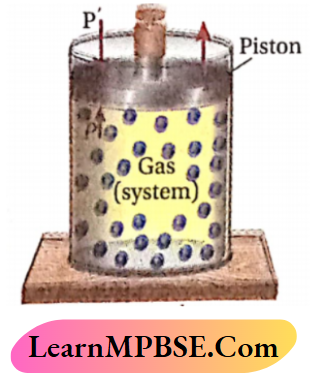
Characteristics of an irreversible process:
In an irreversible process there is an appreciable difference between the driving force and the opposing force (actually, the driving force is greater than the opposing force).
- As a result, such a process takes place at a finite rate, although sometime a very’ slow process may also be irreversible in nature.
- In an irreversible process, the system does not remain in thermodynamic equilibrium at any stage during the Examples: O The flow of heat from an object of higher process.
- If an irreversible process is reversed and the system is made to go back to its initial state, then the work done in the backward direction will not be the same as that in the forward direction
- After the completion of an irreversible process, although the system can be brought back to Its initial state, its surroundings cannot be.
- Irreversible processes complete in a finite time.
Irreversible process Examples: The flow of heat from an object of higher temperature to an object of lower temperature.
- The downward flow of water from a mountain.
- The expansion of a gas against zero pressure.
- The formation of curd from milk
- Differences between the reversible and irreversible processes
Isothermal And Adiabatic Process Class 11
Differences between the reversible and irreversible processes:
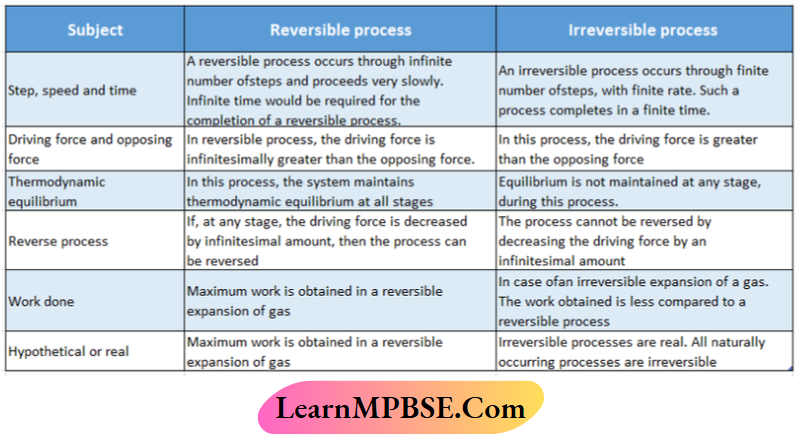
Differences between the reversible and irreversible processes:
